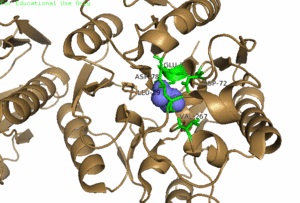User:Kaitlyn Enderle/Sandbox 1
From Proteopedia
(Difference between revisions)
| Line 11: | Line 11: | ||
== Relevance == | == Relevance == | ||
| + | DDAH works to hydrolyze MMA and ADMA. Both MMA and ADMA competitively inhibit NO synthesis by inhibiting Nitric Oxide Synthase (NOS). Because NO is highly toxic, freely diffusible across membranes, and its radical form is fairly reactive, cells must maintain a large control on concentrations by regulating NOS activity and the activity of enzymes such as DDAH that have an indirect effect of the concentration of NO. An imbalance of NO contributes to several diseases. Low NO levels, potentially caused by low DDAH activity and therefore high MMA and ADMA concentrations, have been implicated with diseases such as uremia, chronic heart failure, atherosclerosis, and hyperhomocysteinemia. High levels of NO have been involved with diseases such as septic shock, migraine, inflammation, and neurodegenerative disorders. Because of the effects on NO levels and known inhibitors to DDAH, regulation of DDAH may be an effective way to regulate NO levels therefore treating the diseases. | ||
== Structural highlights == | == Structural highlights == | ||
Revision as of 13:23, 14 March 2017
Dimethylarginine Dimethylaminohydrolase I Bos Taurus
| |||||||||||
References
- ↑ Hanson, R. M., Prilusky, J., Renjian, Z., Nakane, T. and Sussman, J. L. (2013), JSmol and the Next-Generation Web-Based Representation of 3D Molecular Structure as Applied to Proteopedia. Isr. J. Chem., 53:207-216. doi:http://dx.doi.org/10.1002/ijch.201300024
- ↑ Herraez A. Biomolecules in the computer: Jmol to the rescue. Biochem Mol Biol Educ. 2006 Jul;34(4):255-61. doi: 10.1002/bmb.2006.494034042644. PMID:21638687 doi:10.1002/bmb.2006.494034042644

